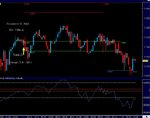timsk
Legendary member
- Messages
- 8,827
- Likes
- 3,527
Hi Tai,I think what I am struggling with is "do I exit on my opposite trade setting up?" This is what I was taught to do and what my rules say. So I can exit on an 1 minute divergence context going the other way.
The implied logic of this is that you operate a stop and reverse policy and, therefore, you're in the market all the time. I suspect that's not the case, so either you're not executing the exit strategy as dictated by your trade plan or it doesn't work as you'd hoped it would! Assuming you don't want to be in the market 24/7, this probably needs some looking at.
My personal view about exits is that they tend to be a compromise. We look through our trades and, with the benefit of hindsight, pick the optimum point to have closed them out. We then devise an exit strategy based on our findings to use in the future which will enable us to maximise any gains made. However, it must reflect our views and feelings about the market. Marrying the optimal exit point with a strategy that takes you out there that you're comfortable executing is the really tricky bit. The strategy you use to get out of the trade is, IMO, even more important that the one used to get into it. This is because exits are so much harder than entries and, whatever strategy or technique one uses, it will (probably) have an impact on the entry and, almost certainly, the stop loss strategy employed for the trades that go against us. In theory, I'm in favour of reverse engineering a trade so that one starts with the exit, then decides on the stop loss and, lastly, works out the entry. But this is counter-intuitive and I confess that I struggle with the issue of exits as much as the next person!
Tim.


